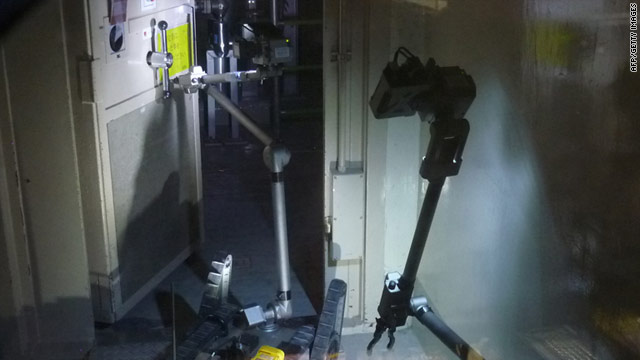April 19, 2011 -- Updated 1040 GMT (1840 HKT)
Tokyo (CNN) -- A robot probe found sauna-like conditions inside the No. 2 reactor building at the Fukushima Daiichi nuclear power plant but lower levels of radiation than in other damaged units, the plant's owner reported Tuesday.
Reactor No. 2 is believed to be leaking water, thousands of tons of which are filling the basement of its turbine plant and utility tunnels. A robot inserted into the unit's reactor building Monday found temperatures up to 41 degrees Celsius (106 F) and humidity ranging from 94-99 percent, the Tokyo Electric Power Company reported Tuesday.
Those conditions fogged up the lenses of the probe's cameras, forcing operators to withdraw the device after a few minutes, company officials said. But the radiation levels were low enough that workers might be able to re-enter the building for short periods of time, Tokyo Electric officials said.
The robot clocked a radiation level of 4.1 millisieverts per hour -- less than 10% of the amount found in the No. 1 and No. 3 reactor buildings on Sunday. By comparison, the average resident of an industrialized country receives a dose of about 3 millisieverts per year. A CT scan produces just under 7, and a chest X-ray delivers a one-time dose of about .05 millisieverts.
 Inside a 'ghost town'
Inside a 'ghost town'  9 months to shut down Japan's reactors?
9 months to shut down Japan's reactors?  Chernobyl survivors speak out
Chernobyl survivors speak out Doses above 100 millisieverts can increase the long-term risk of cancer, while 1,000 millisieverts can produce radiation sickness. Tokyo Electric said 29 workers, including three subcontractors, had received cumulative doses of more than 100 millisieverts to date.
Meanwhile, workers at the plant began pumping the first of the highly radioactive fluid from unit 2's service tunnels into a storage tank for contaminated water Tuesday, said Hidehiko Nishiyama, the chief spokesman for Japan's Nuclear and Industrial Safety Agency.
The treatment facility could hold as much as 30,000 tons of water, according to Tokyo Electric. Nishiyama told reporters Tuesday that as much as 70,000 tons of contaminated water may lie in the darkened spaces beneath the turbine plants, where much of the equipment that normally cools the reactors is housed.
"The plan is to install a purification device so that we can purify the water and then free up some space to store the additional contaminated water," he said.
Some of the treated water would be used to cool the reactors, replacing some of the 6-7 cubic meters (1,600-1,800 gallons) of water now being pumped into each reactor every hour. An unknown percentage of that water is being lost to steam or leaks inside the plant, particularly in unit 2.
Engineers began deploying the U.S.-built "Packbots" into the reactors on Sunday in hopes of getting a better view of conditions inside the buildings. High radiation readings have kept workers out for weeks -- and for unit 1, the images produced were the first glimpse inside the facility since March 12.
Cooling systems at Fukushima Daiichi, about 240 km (150 miles) north of Tokyo, were knocked out by the massive tsunami that struck Japan's Pacific coast after a massive earthquake March 11. The disaster triggered the worst nuclear accident since Chernobyl as the cores of reactors 1-3 overheated and spewed huge amounts of radioactive contamination across the surrounding area.
The buildings that house reactors 1 and 3 were blown apart by hydrogen explosions in the first days of the crisis. Another hydrogen buildup is believed to have ruptured a water reservoir beneath the No. 2 reactor, and the pools housing spent but still-energetic fuel assemblies are concerns in units 1, 3 and 4.
Tokyo Electric this week laid out a six- to nine-month timetable for winding down the crisis and bringing the reactors to a complete shutdown.
The disaster has led to mandatory evacuations of about 78,000 people living within 20 km (12.5 miles) of the plant and orders to people living another 10 km away to remain sheltered, affecting another 60,000-plus. Several towns both inside and outside that radius were told to prepare to evacuate soon, while others have been directed to stand by for further instructions.

